The Tokyo Olympics ended last August. Many athletes set a new world record, raising the limit of mankind to a higher place once again. The reason many people are passionate about sports is probably because of the tenacity of endlessly challenging themselves to overcome their limitations and the beauty of the will that the process creates.
Even in this civilized society we live in, challenges and developments that ‘go beyond the limits’ have been built up one after another. The steam engines have opened a new world by breaking through the limits of existing power, and machine learning and artificial intelligence technologies are once again opening a new era. Our society is like a huge clockwork that turns around trying to overcome these limits and using its heritage as a cogwheel.
However, there was something neglected to be taken care of because we were busy moving the clockwork. The limit that must not be passed on has come to the Earth where we live and breathe. The Earth’s temperature of 1.5°C is that limit. The UN IPCC, an organization that studies the ‘normal temperature’ of the Earth, warned that our descendants will also be able to live healthy and comfortable on Earth only if the average temperature of the Earth does not rise by more than 1.5℃ above pre-industrial levels by the year 2100.
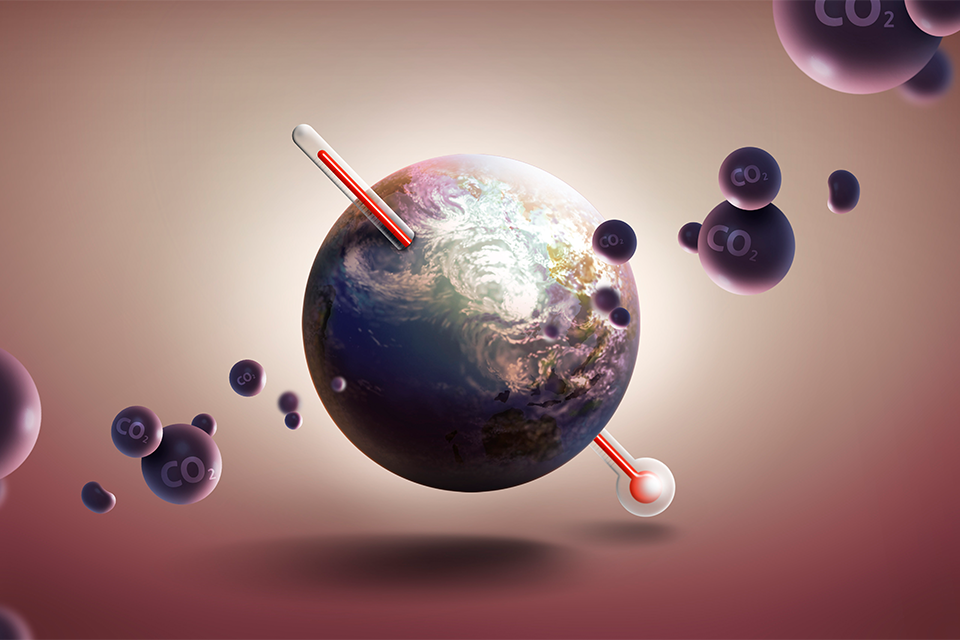
However, it is not possible to recklessly stop the spinning clockwork overnight. We, mankind, desperately need a new cogwheel that can reduce the greenhouse gas generated by the rotation of the clockwork.
If so, a more fundamental challenge lies ahead of us. What should mankind use to make a new cogwheel from now on?
l Back to Basic. There was always ‘Steel’.
When you can’t come up with a clear answer, how about going back to the basics and looking for a clue? Let’s think about what this huge civilized society has been made of. At the center of it was always ‘Steel’.
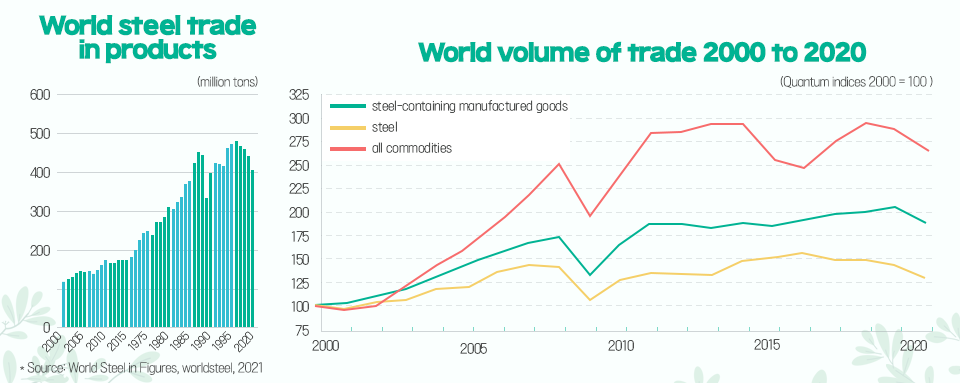
We have distinguished the times through the materials mainly used by mankind, and as of 2021, we are still living in the ‘Iron Age’.
Steel is used in buildings, roads, ships, and even small living tools for reasons such as high strength, durability, and excellent economic feasibility. Steel has a lot of production as it is used in a variety of ways, and of course, the trade is active. In 2020 alone, 1.878 billion tons of steel were produced worldwide, of which 400 million tons crossed the sea and reached the export route.
As there are many uses and trades, the production increases, and the more it is produced, the more carbon emissions inevitably increase. The steel industry emits 7-9% of the world’s greenhouse gases.* For this reason, sometimes steel is perceived as a material far from the low-carbon era, and we even feel pressure to find Sustainable alternative materials and escape the ‘Iron Age’.
*Source: Policy paper: climate change and the production of iron and steel (worldsteel)
In the era of low carbon, has steel become a material to say goodbye to? However, if you see the life of steel for a long time, from the birth, disposal, and recycling of steel, you will have a different opinion.
l Pretty with a long gaze. So is Steel.
*Video clip source: Ministry of Environment Youtube channel (https://youtu.be/ELTbvTLmnCU)
The crushed can takes the place of the troubles the car is going through and says with all its might. “I’m Your Father.”
This is a scene from a public service advertisement by the Ministry of Environment that says that even garbage has a genealogy. (Won the 2015 Korea Advertising Awards) What is the reason for taking the trouble of removing the label from the plastic bottle and carefully removing the tape from the delivery box? This is because of the expectation that items that have been separated and discharged, as in the advertisements, can become new items again if they gather by material and go through reprocessing.
In order to understand the impact of materials on the actual environment, Life Cycle Assessment* from the perspective of a circular economy that evaluates the overall key factors of production from the raw material collection, processing, use to disposal is essential. Let’s take a look at Steel’s long life by following this point of view.
*Life Cycle Assessment (LCA): Objective environmental impact assessment methodology that can analyze and quantify their potential environmental impact by considering the amount of energy and raw materials used or emitted in the extraction of raw materials, raw material production, product production, transportation, use, and disposal and environmental loads such as pollutants or emissions discharged into the environment.
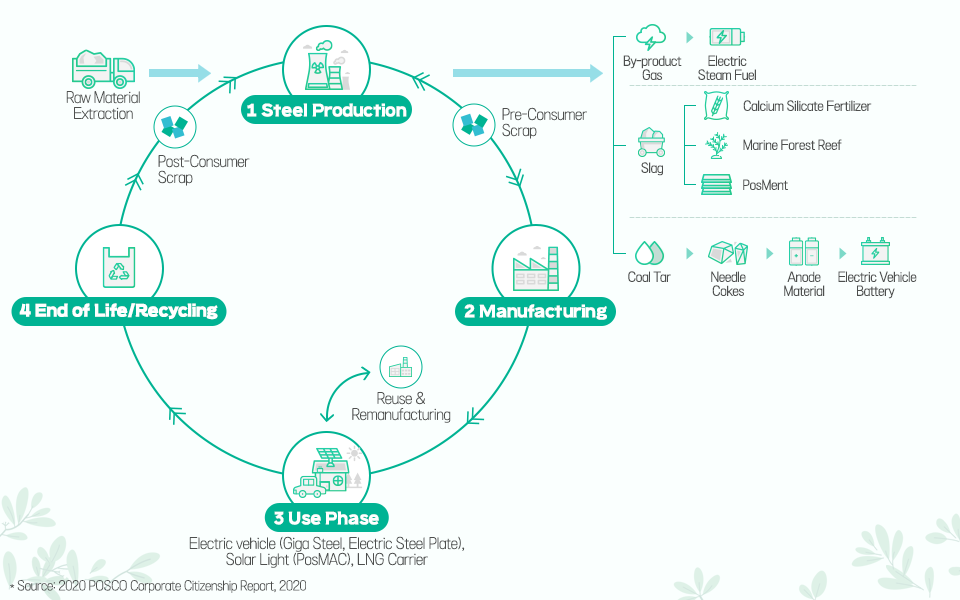
l Steel is a low-carbon material since birth?
The first thing to look at is the production phase. Although steel consumes a large amount of energy in the production process, by-products generated in the process are recycled to improve efficiency. Slag, a representative by-product, is recycled as cement. 96.3% of by-products generated in the global steel production process are recycled.
POSCO recycles 98.8% of by-products, and blast furnace slag is a rock-based material left over from the production of molten iron in the blast furnace and is entirely recycled with cement clinker substitutes and calcium silicate fertilizer. Steel slag is generated in the process of refining molten iron in a converter or an electric furnace and is used as a substitute for construction materials or aggregates. The coal tar is processed into raw material for anode material, which is a key material for the secondary battery. Aside from recycling by-products, what about the amount of carbon dioxide actually generated in the production phase?
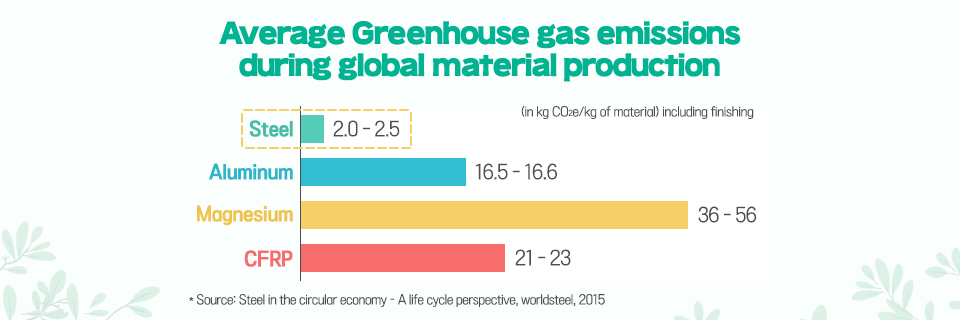
According to the World Steel Association, when 1 ton of steel, aluminum, magnesium, and Carbon Fiber Reinforced Plastic (CFRP) is made, the average amount of carbon generated is 2.3 tons of steel, 16.5 tons of aluminum, 46 tons of magnesium, and 22 tons of CFRP and Steel emits the smallest amount of carbon per material production. However, as mentioned above, steel has significantly higher production than other materials due to its excellent characteristics, resulting in high total carbon emissions from the entire steel industry.
Of course, there is a kind of inherent limitation in generating carbon dioxide because steel also uses coal as a reducing agent for iron ore in the process of making steel. In order to ultimately overcome this, various technologies are being developed to reduce carbon dioxide emissions in the production process of steel. Methods such as hydrogen reduction and carbon capture are being discussed, and these technologies will be discussed in detail in the following episode.
l Light and long-lasting steel! It’s not over until it is over
Let’s move on to the next phase of material manufacturing and look at carbon emissions from the perspective of material use, that is, product manufacturing.
We compared the case of making one car, a representative steel demanding item, into conventional steel, Advanced High-Strength Steel, aluminum, CFRP, and magnesium.
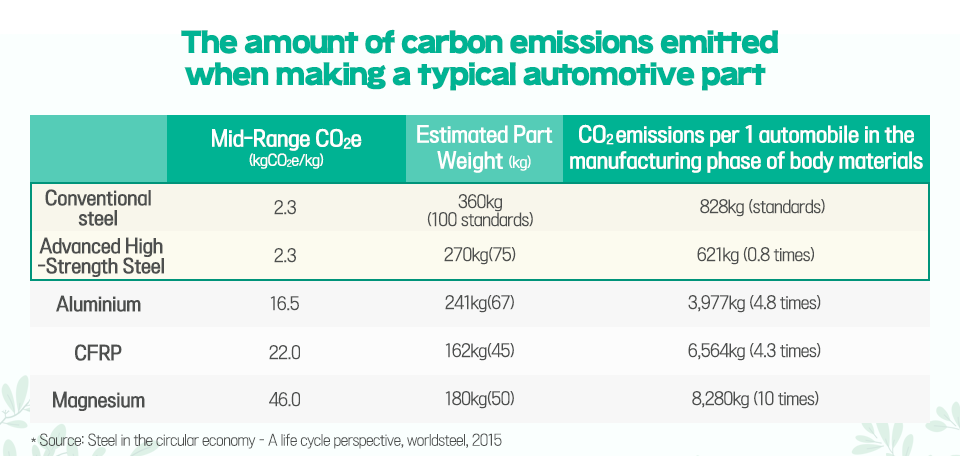
An average of 900kg of steel plate is used for one car, of which about 360kg (40%) of steel plate is used for the body part. When the body (frame, panel, door, trunk) part is made of each material, 828kg of CO2 is emitted when manufactured of conventional steel, while aluminum emits 4.8 times more carbon than conventional steel, CFRP emits 4.3 times, and magnesium emits 10 times more carbon. When using Advanced High-Strength Steel, CO2 emissions are the lowest at 621 kg.
In addition, if a car is made of Advanced High-Strength Steel, the total weight of the vehicle can be reduced by 25% compared to that of conventional steel. Assuming that a typical five-seater family car is made, the total weight of the vehicle is reduced by 100 to 150 kg, and thanks to the lighter body, considering the entire lifespan from production to disposal, there is an effect of reducing about 2-3 tons of greenhouse gases.*
*Source: worldautosteel, worldsteel “steel in automotive”
Having looked at the amount of carbon dioxide generated in the manufacturing and product use phases, it is now time to look at the post-use phases.
The steel once born is not ‘over until it is over’. Steel has magnetism, so it is easy to separate. It can be recycled even if foreign substances are attached, or even crushed or broken. Recycling does not significantly reduce the original value of the material. When scrap metal is dissolved again with molten iron to remove impurities, a new steel product is created. Thanks to such high recyclability, 85% of the iron once born is recycled again, especially at least 90% of the steel used in automobiles is recycled.

Compared to other materials, the recycling rate of steel is overwhelming, and the emission of CO2 generated during the recycling stage is 0.71 tons per ton, whereas aluminum and magnesium emit 2–3 times higher.
l Still… Steel!
Steel is one of the most produced materials in the world. Due to its high strength and economic feasibility, there is a high demand, naturally, there is a high production, and the total amount of CO2 generated in the production process is also high. However, as seen above, from a life-cycle perspective of the material, steel generates less carbon when manufacturing compared to other materials, emits relatively less carbon when manufacturing and using products, and is highly recyclable, making it still valuable in the era of low carbon.
Everyone is working hard to achieve Net-zero carbon 2050. But we cannot stop this society in an instant to stop carbon emissions. In many places, new infrastructure is still needed and means of transportation to connect is needed. If we can’t stop this huge movement of the clockwork that turns our society in a moment, what are the choices we can make? From a life cycle perspective, isn’t it the answer in our hands to choose a material that emits relatively little carbon, that is, steel?
Still Steel though!
In the next episode of Walking together with POSCO’s Net-zero carbon 2050 roadmap, we plan to learn about ‘Hydrogen Reduction Steel’ technology, an essential gateway for Sustainable steel. If you are curious about what hydrogen reduction steel is, why is it essential, and what POSCO’s hydrogen reduction steel technology “HyREX” is, look forward to the next episode.
